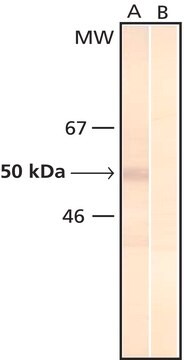ABN1710
Anti-CEP290
from rabbit
Synonim(y):
Cep290, Bardet-Biedl syndrome 14 protein homolog, Nephrocystin-6
About This Item
Polecane produkty
pochodzenie biologiczne
rabbit
Poziom jakości
forma przeciwciała
affinity isolated antibody
rodzaj przeciwciała
primary antibodies
klon
polyclonal
reaktywność gatunkowa
rat, human, mouse
metody
immunocytochemistry: suitable
immunofluorescence: suitable
immunohistochemistry: suitable
immunoprecipitation (IP): suitable
western blot: suitable
numer dostępu NCBI
numer dostępu UniProt
Warunki transportu
ambient
docelowa modyfikacja potranslacyjna
unmodified
informacje o genach
mouse ... Cep290(216274)
Opis ogólny
Specyficzność
Immunogen
Zastosowanie
Immunoprecipitation Analysis: A representative lot detected CEP290 in WT and rd16 retinal extract(Chang, B., et. al. (2006). Hum Mol Genet. 15(11):1847-57).
Immunohistochemistry Analysis: A representative lot detected CEP290 in WT mouse retina (Chang, B., et. al. (2006). Hum Mol Genet. 15(11):1847-57).
Western Blotting Analysis: 1:1,000-1:2,000 dilution from a representative lot detected CEP290 in mouse retina (Courtesy of Dr. Tiansen at NIH).
Immunofluorescence Analysis: A representative lot detected CEP290 in ciliated sensory cells (Rachel, R.A., et. al. (2012). J Clin Invest. 122(4):1233-45) and WT mouse retina (Chang, B., et. al. (2006). Hum Mol Genet. 15(11):1847-57).
Immunofluorescence Analysis: 1:500-1:2,000 dilution from a representative lot detected CEP290 in frozen mouse retina (Courtesy of Dr. Tiansen at NIH).
Immunocytochemistry Analysis: A representative lot detected CEP290 in IMCD-3 cells (Chang, B., et. al. (2006). Hum Mol Genet. 15(11):1847-57).
Jakość
Western Blotting Analysis: 1:500 dilution of this antibody detected CEP290 in 10 µg of HEK293 cell lysate.
Opis wartości docelowych
Postać fizyczna
Inne uwagi
Nie możesz znaleźć właściwego produktu?
Wypróbuj nasz Narzędzie selektora produktów.
Kod klasy składowania
10 - Combustible liquids
Klasa zagrożenia wodnego (WGK)
WGK 2
Certyfikaty analizy (CoA)
Poszukaj Certyfikaty analizy (CoA), wpisując numer partii/serii produktów. Numery serii i partii można znaleźć na etykiecie produktu po słowach „seria” lub „partia”.
Masz już ten produkt?
Dokumenty związane z niedawno zakupionymi produktami zostały zamieszczone w Bibliotece dokumentów.
Nasz zespół naukowców ma doświadczenie we wszystkich obszarach badań, w tym w naukach przyrodniczych, materiałoznawstwie, syntezie chemicznej, chromatografii, analityce i wielu innych dziedzinach.
Skontaktuj się z zespołem ds. pomocy technicznej




